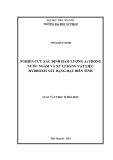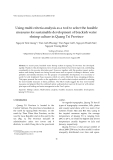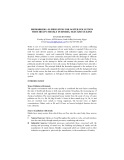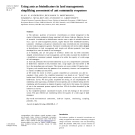
Tác hại của as
-
Arsenic (As) là một nguyên tố có trong tự nhiên và ở trên bề mặt của vỏ trái đất chiếm khoảng 1 đến 2 mg Asen/kg Là một kim loại nặng. As tinh khiết có màu xám và ở dạng tinh thể rắn. Số thứ tự 33 trong bảng HTTH M = 74.92159g/mol; d = 5.73 g/cm3 Hầu hết các hợp chất As vô cơ và hữu cơ đều là bột màu trắng hoặc không màu, không bay hơi, không có vị đặc biệt. Vì vậy rất khó nói rằng trong thực phẩm, nước, không khí có hay không sự hiện...
 102p
102p  anhthaopro
anhthaopro
 12-04-2011
12-04-2011
 217
217
 80
80
 Download
Download
-
Nội dung chính của đề tài là tìm ra qui trình chế tạo vật liệu graphene bằng phương pháp điện ly plasma. Xây dựng mô hình lý thuyết để giải thích cơ chế tạo thành graphene dưới sự tác động của plasma trên cả hai điện cực. Tìm cách minh họa ứng dụng của vật liệu graphene chế tạo được thông qua xử lý hấp phụ As(III) trong môi trường nước. Mời các bạn cùng tham khảo!
 80p
80p  interstellar
interstellar
 18-09-2021
18-09-2021
 44
44
 7
7
 Download
Download
-
Mục tiêu nghiên cứu của luận văn nhằm xác định mức độ nhiễm As trong một số nguồn nước ngầm, đánh giá mức độ ô nhiễm nguồn nước và đề xuất giải pháp xử lí nhằm giảm thiểu tác hại của As đến sức khỏe con người. Mời các bạn cùng tham khảo!
 72p
72p  generallady
generallady
 16-07-2021
16-07-2021
 24
24
 4
4
 Download
Download
-
Trong những năm gần đây, nuôi tôm nước lợ ở tỉnh Quảng Trị đã phát triển nhanh chóng. Nhờ sự phát triển này, cuộc sống của nhiều nông dân địa phương đã được cải thiện, góp phần đáng kể vào mục tiêu xóa đói giảm nghèo. Tuy nhiên, cùng với tác động tích cực này, chính sách các nhà hoạch định và nông dân nuôi tôm đang phải đối mặt với một số vấn đề như sự lây lan của bệnh tôm, ô nhiễm nước và xâm nhập mặn. Với mục đích phát triển bền vững, nó là cần thiết...
 0p
0p  hoatuongvihong
hoatuongvihong
 15-11-2011
15-11-2011
 62
62
 5
5
 Download
Download
-
Water is one of our most important natural resources, and there are many conflicting demands upon it. Skilful management of our water bodies is required if they are to be used for such diverse purpose...
 13p
13p  nhoxden_20101991
nhoxden_20101991
 13-06-2011
13-06-2011
 89
89
 5
5
 Download
Download
-
The indicator qualities of terrestrial invertebrates are widely recognized in the context of detecting ecological change associated with human land-use. However, the use of terrestrial invertebrates as bioindicators remains...
 16p
16p  nhoxden_20101991
nhoxden_20101991
 13-06-2011
13-06-2011
 91
91
 5
5
 Download
Download
CHỦ ĐỀ BẠN MUỐN TÌM



















